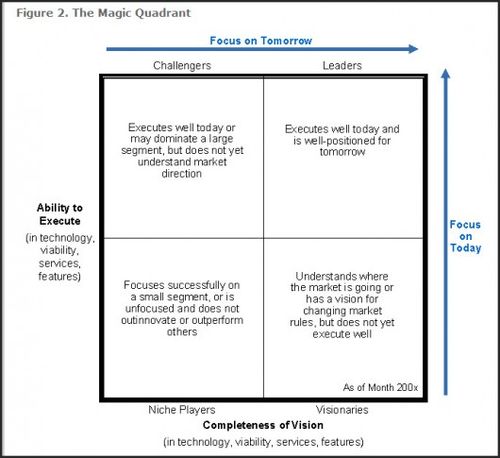Lately, I feel as if I have been spending an inordinate amount of time with my companies talking about marketing. Related to this, one of my portfolio companies recently received a number of nice emails from the board related to its new positioning in Gartner's Magic Quadrant. We were all quite excited since we made demonstrable progress over the last 3 years from niche player to visionary and on the cusp of becoming a leader. Yes, I know what you are thinking – this is all BS and how much did you pay them over the years. And where there is smoke there is fire as those statements ring true but at the end of the day Gartner's Quadrant is important for anyone selling to IT professional because buyers of technology care about what Gartner has to say. Technologists at corporations are not paid to take risks, but rather to not make mistakes, to make the safe choice. And guess what, paying Gartner Group for an annual subscription to its content and for access to its analysts helps IT buyers make the safe choice. Secondly, larger companies when looking to expand their product line or get better positioning in the market definitely do pay some attention to the start-ups on the quadrant.
For those of you who are not familiar with the Quadrant, you can read more about it here. In short, it is Gartner Group's proprietary methodology to rate IT vendors in a particular market based on Ability to Execute and Completeness of Vision.  In the end, every market is broken out into 4 quadrants, Leaders (top right), Challengers (top left), Niche Players (bottom left), and Visionaries (bottom right). For the most part, Leaders and Ability to Execute comes down to number of customers and customer references that Gartner has done and the size of your company and ability to go to market. Based on this criteria, you will never see startups in the Leaders quadrant on Day 1. However, what you should expect from a startup is a visionary position meaning the company has some phenomenal technology that fits a market need and is leading the future of the industry but at the same time does not have the customer base or resources to go after the big boys today. If you are in the niche category then good luck.
In the end, every market is broken out into 4 quadrants, Leaders (top right), Challengers (top left), Niche Players (bottom left), and Visionaries (bottom right). For the most part, Leaders and Ability to Execute comes down to number of customers and customer references that Gartner has done and the size of your company and ability to go to market. Based on this criteria, you will never see startups in the Leaders quadrant on Day 1. However, what you should expect from a startup is a visionary position meaning the company has some phenomenal technology that fits a market need and is leading the future of the industry but at the same time does not have the customer base or resources to go after the big boys today. If you are in the niche category then good luck.
So how does a start-up navigate the Gartner waters? First, I would read this overview from Gartner to understand how they think and rate vendors. Secondly, I would contact the relevant analyst to set up a meeting to discuss further. Given my experience, I must say that developing a relationship with the analyst is key to helping you improve your standing in the quadrant. This means buying a subscription to Gartner and then hiring the analyst for some consulting. As with any business, you will have some impressive analysts and others who are not as strong. Regardless, I have found that by sharing your ideas and vision for the market with the analysts early on can help them synthesize their views of the market. If you can have your Gartner analyst take your thoughts as his own then you know you have really done a great job in discussing the market. What many companies don't know is that you also have to be proactive about the Magic Quadrant. As you sign up new customers and partners, share them with Gartner so they can call every new customer and partner in advance. Many times companies wait until the last second and inundate Gartner analysts with numerous calls and information and many times these analysts cannot process all of that info which means it will have to wait until the next release of the Quadrant. So all in all, be proactive, don't be afraid to pay as you may learn something and it is a necessary evil, and build a relationship with your analyst. I hope this is helpful and I would love to hear your thoughts and comments on this subject.

